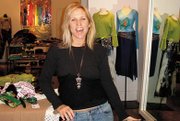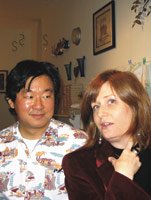L.A.'s Boutique Districts Thrive Despite the Drive
In 2004, established designers such as Michael Kors and Etro prospected the Los Angeles area to build new stores. They are part of a growing wave that’s remaking Los Angeles into a city of boutiques. Home-grown veteran retailers such as Ron Herman and Lisa Kline, overseas designers such as Ted Baker, and stores such as Scout that are breaking new designers have opened for business because the changing urban landscape is encouraging the proliferation of boutiques.
At one time, the Los Angeles area was home to three major boutique districts: Rodeo Drive, Sunset Plaza and Melrose Avenue. These districts still draw new retailers and plenty of customers, but over the past decade, Venice’s Abbot Kinney Boulevard, Santa Monica’s Montana Avenue, Robertson Boulevard, West Third Street, Beverly Boulevard, La Brea Avenue, Silverlake’s Sunset Junction and Echo Park—to name a few—have become retail hot spots, as well.
Boutique districts traditionally need something the city has rarely provided: foot traffic, according to Larry Kosmont, a real estate analyst and former city planner. While the region has a few notable pedestrian districts, including Santa Monica’s Third Street Promenade, it’s the automobile that has mostly shaped Southern California’s development.
Although Los Angeles won’t be giving up its love affair with the car, the popularity of boutique districts has been driven by something no one can control, according to Kosmont.
“Los Angeles has become more dense,” said Kosmont, president and chief executive officer of Los Angeles–based Lee Kosmont Advisory Services. “There are more people per square mile, and traffic becomes more challenging, and people don’t want to travel as much.”
Los Angeles County’s population has grown from approximately 8 million in 1990 to more than 10 million in January 2004, according to the U.S. Census Bureau. But the burgeoning population and congested thoroughfares don’t tell the entire story about the spread of boutiques. That tale is rooted in everything from local government’s growing interest in renovating downtowns to the public’s current tastes.
Consumers are increasingly choosing to spend their dollars at boutiques, which provide an experience not available at bigger retailers, said Pam Danziger, a marketing consultant, the author of the book “Why People Buy Things They Don’t Need” and the president of Unity Marketing in Stevens, Pa.
“We’ve had such an incredible increase in stores over the past 10 years,” Danziger said. “The question is what experience do you want?
While her surveys find that more people shop for luxury at department stores and on the Internet, they also reveal that boutiques attract consumers who consistently look for unique items that cannot be found in chain stores.
Entrepreneurial spirit
Los Angeles’ independent streak has also helped fuel the boutique scene, prompting new retailers to dive in and fostering design talent who provide fresh merchandise for store shelves.
Kristin Knauff has worked in retail since she was a teen-ager. One of her goals was to own a store because she had many friends who were independent designers. They needed a place to sell, and she wanted to state a case for new designers. So Knauff opened Apartment 3 on La Brea Avenue in 2003, carrying a mix of idiosyncratic designer clothes.
“I originally carried 10 lines from my friends,” Knauff said. “Then it increased. I found friends of friends whose designs were good for the store.”
Independent designers are good business, said Alisa Loftin, co-owner of Aero & Co. on West Third Street. “Boutiques can’t afford to put out the large budget that bigger labels require. It’s $4,000 to $8,000 to buy a collection for one season,” she said.
If boutique owners spend similar sums on new designers, their stock can stay fresh for up to six months. Or such retailers can spend a modest $800 to $1,500 on a trial run of a new designer, according to Loftin.
“I can keep merchandise looking fresher and experiment with more designers rather than making a huge investment in one designer,” she said. “For me, that’s liberating.”
Katherine Story said it makes economic sense for designers to open up their own stores. Story, who had sold her bohemianchic fashions at X Art & Fashion in her hometown of Laguna Beach, Calif., opened the Katherine Story boutique on West Third Street in 2004 to be closer to her growing base of Los Angeles customers.
“I’m getting retail, not wholesale,” Story said. “I have control.”
A sense of community
There’s a natural tie in when boutique districts spring up in neighborhoods that already have a strong community identity. Donna Choi and her husband, Peter, opened Silverlake boutique Serifos in 2001 and immediately got involved with community events and hosted monthly block parties.
After two successful years, they moved to a larger 850-square-foot Silverlake location in July. Choi partially credits the boutique’s success to their connection to the neighborhood.
“I feel like we can be a meeting place for a lot of people,” she said. “And that’s why people feel connected to our store.”
Boutiques head to the mall
Malls are also getting a taste of boutique style. Retail chains such as Metropark, based in City of Industry, Calif., is just one chain retailer bringing boutique style to shopping centers.
Kevin Kudlo, an executive with mall developer The Mills Corp., said developers are always looking for something different for shopping centers.
“What makes one shopping center stand out is to make it unique. It’s important not to clone one project to another,” said Kudlo, group vice president of development for Tempe, Ariz.–based Mills, which is redeveloping the Del Amo Fashion Center in Torrance, Calif.
Yet Kosmont said most shopping-center leasing agents prefer credit tenants or wellregarded national retailers with a proven track record, such as Anaheim, Calif.–based Pacific Sunwear.
Brand building
More labels have been getting into the act by building their own boutiques. Los Angeles– based BCBG Max Azria, American Apparel and Quiksilver are a few manufacturers that have rolled out either retail divisions or new stores.
“There is an increasing frequency for manufacturers to try it and to try it on a small scale,” said Liz Pierce, a retail analyst with the Los Angeles office of Sanders Morris Harris.
Most manufacturers build a few stores to display their entire collections without being edited by department stores, Pierce said. Many manufacturers refrain from jumping into the business wholeheartedly because they would run the risk of competing with their own distribution channels, she added.
Up north
While Los Angeles is beginning to flex its boutique retailing muscle, Northern California has always been rich in small shops. And the boutique culture is growing in San Francisco, according to Kazuko Morgan, senior director of real estate company Cushman & Wakefield of California Inc. in San Francisco.
Morgan said boutique districts used to occupy single blocks in popular areas such as Hayes Street in Hayes Valley and 24th Street in Noe Valley. But now, she said, they are covering multiple blocks and often putting down roots far from traditional shopping streets. “They’re the equivalent of a small street in Brentwood [in Los Angeles], smack in the middle of a residential street,” she noted.
The reasons for the expansion are wrapped up in San Francisco’s unique culture. The city has laws restricting the growth of big chain stores. Morgan said the city’s landlords also prefer to lease space quickly, which goes against the long lead times chain retailers often require before moving into a new place.
With commercial rents as high as $48 to $80 per square feet in San Francisco, the cost of doing business is not cheap. But Morgan said San Franciscans reward boutique owners. “The residents are pretty sophisticated, and there’s a good local following for these boutiques,” she said.























